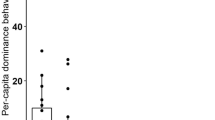Summary
Social regulation of egg production and weight in queens was studied in relation to presence and absence of larvae and workers in the pharaoh's ant,Monomorium pharaonis (L.).
Results were obtained by counting eggs and weighing queens under various conditions.
The results confirm the existence of a positive feed-back loop between mated queens and their larvae as evident from a correlation (Y = 4.575 * X + 6.452) between the number of large worker larvae (X) and the egg yield (Y). This correlation seems to relate to the queens preferential feeding on larval secretions. Queens without larvae maintained a low level of egg production of about 6 eggs/day. Queens deprived of larvae as well as workers stopped producing eggs within 24 hours.
Repletes, special workers, with greatly distended gasters functioned as a buffer retarding decline of egg production by feeding the queens during short periods without larvae.
Similar content being viewed by others
References
Abe, T., Y. Tanaka, H. Miyazaki and Y. Y. Kawasaki, 1991. Comparative study of the composition of Hornet larval saliva, its effect on behaviour and role of trophallaxis.Comp. Biochem. Physiol. 99c:79–84.
Berndt, K.-P. and W. Eichler, 1987. Die Pharaoameise,Monomorium pharaonis (L.) (Hym., Myrmicidae).Mitt. Zool. Mus. Berl. 63:3–186.
Børgesen, L. W., 1989. A new aspect of the role of larvae in the pharaoh's ant society (Monomoriumpharaonis (L.) — Formicidae, Myrmicinae): Producer of fecundity-increasing substances to the queen.Ins. Soc. 36:313–327.
Bourke, A. F. G., 1991. Queen behaviour, reproduction and egg cannibalism in multiple-queen colonies of the antLeptothorax acevorum.Anim. Behav. 42:295–310.
Davison, E. A., 1982. Seed utilization by harvester ants. In:Geobotany vol. 4. Ant-plant interactions in Australia. (Buckley, R.C., Ed.): 1–6.
Edwards, J. P., 1987. Caste regulation in the pharaoh's antMonomorium pharaonis: the influence of queens on the production of new sexual forms.Physiol. Entomol. 12:31–39.
Eisner, T. and G. M. Happ, 1962. The infrabuccal pocket of a formicine ant.Psyche 69:107–116.
Fletcher, D. J. C., M. S. Blum, T. W. Whitt and N. Temple, 1980. Monogyny and polygyny in the fire ant,Solenopsis invicta.Ann, ent. Soc. Am. 73:658–661.
Gibson, R. L. and J. G. Scott, 1990. Influence of cocoons on egg laying of colony-founding carpenter ant queens (Hymenoptera, Formicidae).Ann. ent. Soc. Am. 83:1005–1009.
Hölldobler, B. and E. O. Wilson, 1990.The Ants. Berlin, Springer-Verlag, 732 p.
Hunt, J. H., 1991. Nourishment and the evolution of social Vespidae. pp 426–450 in: Ross, K. G. and R. W. Mathews: The social biology of wasps.Comstock Publishing Associates, 678 p.
Hunt, J. H. and C. A. Nalepa, 1994. Nourishment and evolution in insect societies.Westview Press, publ. Boulder, Colorado.
Keller, L., 1988. Evolutionary implications of polygyny in the Argentine ant,Iridomyrmex humilis (Mayr.) (Hymenoptera: Formicidae): an experimental study.Anim. Behav. 36:159–165.
Masuko, K., 1986. Larval haemolymph feeding: A nondestructive parental cannibalism in the primitive antAmblyopone silvestrii Wheeler (Hymenoptera, Formicidae).Behav. Ecol. Sociobiol. 19:249–255.
Masuko, K., 1990. Behaviour and ecology of the enigmatic antLeptanilla japonica Baroni Urbani (Hymenoptera: Formicidae: Leptanillinae).Ins. Soc. 37:31–57.
Mercier, B., L. Passera and J. P. Suzzoni, 1985. Etude de la polygenie chez la fourmiPlagiolepsis pygmaea Latr. (Hymenoptera, Formicidae). I. La fécondité des reines en condition expérimentale monogyne.Ins. Soc. 32:335–348.
Ohly-Wüst, M., 1977, Soziale Wechselbeziehungen zwischen Larven und Arbeiterinnen im Ameisenstaat, mit besonderer Beachtung der Trophallaxis. Dissertation. Frankfurt am Main.
Peacock, A. D., 1950. Studies in pharaoh's antMonomorium pharaonis (L.). 4. Egg-production.Entomologist's mon. Mag. 86:294–298.
Petersen-Braun, M. D., 1973. Untersuchungen der PharaoameiseMonomorium pharaonis (L.) (Hymenoptera, Formicidae). Dissertation. Bonn.
Petralia, R. S., A. A. Sorensen and S. B. Vinson, 1980. The labial gland system of the imported fire ant,Solenopsis invicta Buren.Cell Tissue Res. 206:145–156.
Sorensen, A. A., R. S. Kamas and S. B. Vinson, 1983. The influence of oral secretions from larvae on levels of proteinases in colony members ofSolenopsis invicta Buren (Hymenoptera: Formicidae).J. Insect Physiol. 29:163–168.
Tschinkel, W. R., 1988. Social control of egg-laying rate m queens of the fire ant,Solenopsis invicta.Physiol. Entomol. 13:327–350.
Vargo, E. L., 1992. Mutual pheromonal inhibition among queens in the polygyne colonies of the fire antSolenopsis invicta.Behav. Ecol. Sociobiol. 31:205–210.
Villet, M. H., S. A. Hanrahan and C. Walther, 1990. Larval structures associated with larva-to-adult trophallaxis inPlatythyrea (Hymenoptera: Formicidae).J. Insect Morphol. & Embryol. 19 (5/6):243–256.
Went, F. W., J. Wheeler and G. C. Wheeler, 1972. Feeding and Digestion in some Ants (Veromessor and Monica).Bioscience 22:82–88.
Wilson, E. O., 1974. The population consequence of polygyny in the antLeptothorax curvispinosus.Ann. ent. Soc. Am. 67:777–780.
Zar, J. H., 1974. Biostatistical Analysis. Prentice-Hall, Inc.
Author information
Authors and Affiliations
Rights and permissions
About this article
Cite this article
Børgesen, L.W., Jensen, P.V. Influence of larvae and workers on egg production of queens of the pharaoh's ant,Monomorium pharaonis (L.). Ins. Soc 42, 103–112 (1995). https://doi.org/10.1007/BF01245702
Received:
Revised:
Accepted:
Issue Date:
DOI: https://doi.org/10.1007/BF01245702




